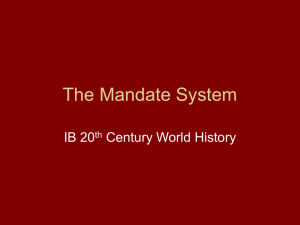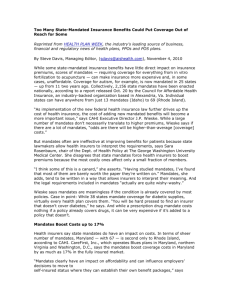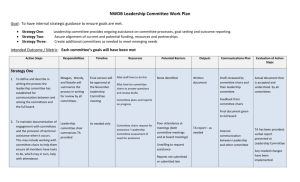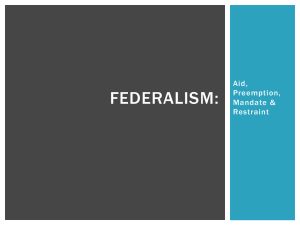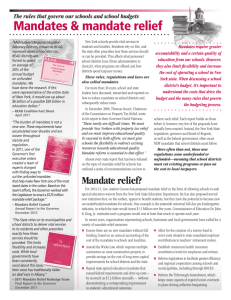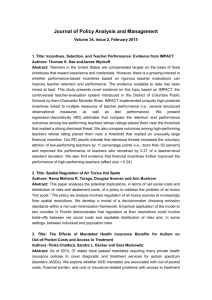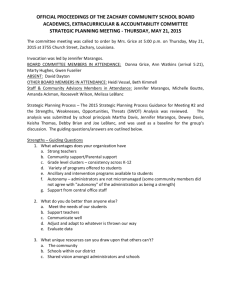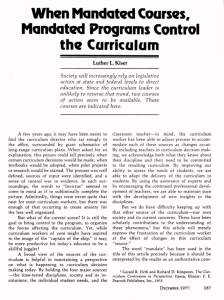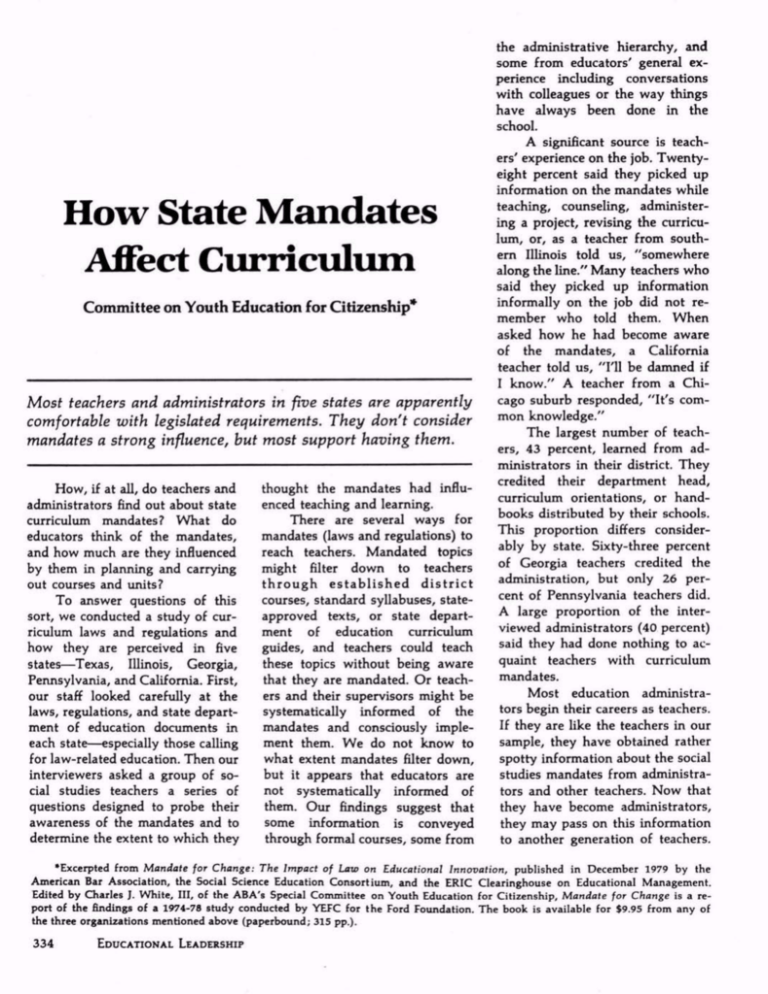
How State Mandates
Affect Curriculum
Committee on Youth Education for Citizenship*
Most teachers and administrators in five states are apparently
comfortable with legislated requirements. They don't consider
mandates a strong influence, but most support having them.
How, if at all, do teachers and
administrators find out about state
curriculum mandates? What do
educators think of the mandates,
and how much are they influenced
by them in planning and carrying
out courses and units?
To answer questions of this
sort, we conducted a study of cur
riculum laws and regulations and
how they are perceived in five
states Texas, Illinois, Georgia,
Pennsylvania, and California. First,
our staff looked carefully at the
laws, regulations, and state depart
ment of education documents in
each state especially those calling
for law-related education. Then our
interviewers asked a group of so
cial studies teachers a series of
questions designed to probe their
awareness of the mandates and to
determine the extent to which they
thought the mandates had influ
enced teaching and learning.
There are several ways for
mandates (laws and regulations) to
reach teachers. Mandated topics
might filter down to teachers
through established district
courses, standard syllabuses, stateapproved texts, or state depart
ment of education curriculum
guides, and teachers could teach
these topics without being aware
that they are mandated. Or teach
ers and their supervisors might be
systematically informed of the
mandates and consciously imple
ment them. We do not know to
what extent mandates filter down,
but it appears that educators are
not systematically informed of
them. Our findings suggest that
some information is conveyed
through formal courses, some from
the administrative hierarchy, and
some from educators' general ex
perience including conversations
with colleagues or the way things
have always been done in the
school.
A significant source is teach
ers' experience on the job. Twentyeight percent said they picked up
information on the mandates while
teaching, counseling, administer
ing a project, revising the curricu
lum, or, as a teacher from south
ern Illinois told us, "somewhere
along the line." Many teachers who
said they picked up information
informally on the job did not re
member who told them. When
asked how he had become aware
of the mandates, a California
teacher told us, "I'll be damned if
I know." A teacher from a Chi
cago suburb responded, "It's com
mon knowledge."
The largest number of teach
ers, 43 percent, learned from ad
ministrators in their district. They
credited their department head,
curriculum orientations, or hand
books distributed by their schools.
This proportion differs consider
ably by state. Sixty-three percent
of Georgia teachers credited the
administration, but only 26 per
cent of Pennsylvania teachers did.
A large proportion of the inter
viewed administrators (40 percent)
said they had done nothing to ac
quaint teachers with curriculum
mandates.
Most education administra
tors begin their careers as teachers.
If they are like the teachers in our
sample, they have obtained rather
spotty information about the social
studies mandates from administra
tors and other teachers. Now that
they have become administrators,
they may pass on this information
to another generation of teachers.
Excerpted from Mandate for Change: The Impact of law on Educational Innovation, published in December 1979 by the
American Bar Association, the Social Science Education Consortium, and the ERIC Clearinghouse on Educational Management.
Edited by Charles J. White, III, of the ABA's Special Committee on Youth Education for Citizenship, Mandate for Change is a re
port of the findings of a 1974-78 study conducted by YEFC for the Ford Foundation. The book is available for $9.95 from any of
the three organizations mentioned above (paperbound; 315 pp.).
334
EDUCATIONAL LEADERSHIP
Looking at the whole process, we
get a sense of the mandates as a
kind of lore passed on by succes
sive generations of administrators
and teachers.
There is a much more formal
process to inform teachers and
administrators of changes in the
mandates. When teachers were
asked how they became aware of
changes, 81 percent gave adminis
trators as a source for such infor
mation, about twice as many as
credited administrators with in
forming them of the mandates
themselves.
The Influence of State Mandates
Teachers and administrators
say the mandates have some effect,
although the extent apparently
varies from state to state. In re
sponse to our inquiries about lawrelated education, the most strik
ing differences were between
Texas and the other four states.
Teachers in our Texas sample were
far more likely to say that lawrelated education originated with
state requirements and far less
likely to say they made the crucial
decisions themselves. Half of our
respondents said they played no
role in developing law-related
offerings. They "covered the text,"
which had been selected from a
short list of state approved books.
They did not develop separate and
distinct courses because it was
difficult to find places for them in
the state-prescribed curriculum.
Georgia, like Texas but unlike
the other three states in our sam
ple, has a statewide list of text
books that are "acceptable." Be
cause the books are screened,
teachers may tend to accept the
texts as the approved program, in
cluding what the texts include and
excluding what the texts exclude.
In Illinois the state has taken
a different approach to regulating
part of the social studies curricu
lum. It requires students to pass
a "Constitution Test," thus requir
ing a certain amount of material
to be developed on the Illinois con
stitution and the U.S. Constitution
and Bill of Rights. Though the
tests are developed locally and
teachers encouraged to teach the
subject according to their own in
terests some Illinois teachers see
this mandate as the origin of law
studies.
In Pennsylvania and Califor
nia, teachers generally do not re
port that the mandates have in
fluenced law studies even though
law-related education is explicitly
recognized by statute in California
as part of the social studies. The
California findings may be in part
because the mandate is new (1974),
and in part because it has no action
component no mandated course,
graduation requirement, or state
wide test.
When interviewers asked
teachers and administrators about
the general effect of the mandates,
they found some interesting varia
tions state by state. In California,
where the mandates are unspecific,
a high of 52 percent of the teach
ers said they ignored them. No
Californians said they were lim
ited by the mandates. By contrast,
in Georgia and Illinois, where the
mandates are quite specific, lows of
36 percent said they ignored them.
These same states had the largest
proportion who said they teach the
subjects because they are required.
Figure 1 shows how the whole
sample (that is, the five state totals)
perceived the effects of the man
dates. Some educators thought
social studies mandates had not in
fluenced teaching at all. Some re
spondents gave the interviewers
short answers such as, "No way,"
"Haven't," and "None." Others,
like a teacher in a middle-sized
Texas city, told us, "I pick the ones
I want and like; the rest I just for
get about." Another from Califor
nia said, "They have a minimal
effect. There is no enforcement. No
one checks."
Administrators are less likely
than teachers to say that mandates
have no effect, and they are more
likely to see the mandates as a
minimum requirement leaving
room for a great number of local
options. A Pennsylvania principal
said,
Until we wised up, they were
sort of limiting, but it was just us.
What happens is we became tradition
bound. They came out with the title
"World History," and we taught the
course World History. But we've
realized that there is actually a lot of
flexibility in 9-to-lS-week courses.
We can cover more interesting topics
that are still under the umbrella of
the law.
At the other extreme, less than
a fifth of teachers and administra
tors said that topics were specifi-
The Committee on Youth
Education for Citizenship is a
special committee of the Amer
ican Bar Association, Joel Henning (top, left), Project Direc
tor. For the study of state man
dates, Michael Sorgen (top,
right) was legal researcher;
Leigh Stelzer (bottom, left) was
empirical
researcher;
and
Charles 1. White, III, (bottom,
right) was editor.
JANUARY 1980
335
Figure 1. How Teachers and Administrators (Superintendents and Principals)
Perceived the Influence of Social Studies Mandates on Teaching*
Influence of Social
Studies Mandates
Administrator*
Teachers
(N = 1 97)_______(N =96)
Mo Influence
They have no influence.
43 percent
25 percent
Some Influence
Mandates reinforce
teaching. The aubjecta
would be taught anyway.
Mandate* help by telling
what la expected.
12
10
13
13
16
24
17
17
Mandate! tell what la
expected but leave a lot
of room for additions.
Considerable Influence
• The subjeeta are taught
because they are required.
Mandatea limit teaching
by requiring aubjecta that
are not alwaya relevant
or important.
Other
No Change
3
4
5
7
Percentages add up to more than 100% becauae some respond
ents gave more than one answer.
cally included in response to state
requirements.
Perhaps some teachers told us
a little more than they intended
when they praised the state re
quirements. A teacher in the San
Antonio area told us, "I abide by
them and I agree that they are
good. They tell you when there
should be changes or additions to
a course." A teacher in the Atlanta
area told us how state require
ments had changed his life:
I've become more aware of so
cial problems. They have increased
my understanding of the relationship
between the state, local, national, and
international government. I've taken
more interest since I've been teaching
social studies. Since it's a state re
and Texas.) Another one-third
said they were moderately impor
tant, and the final one-third said
they were of minor or no impor
tance.
The data suggest that teachers
do not see the mandates as an im
position. On the contrary, those
who report an effect are more
likely to see it as beneficial. By a
three-to-one margin, teachers and
administrators suggested the man
dates helped their teaching or sup
ported a sound curriculum.
quirement, a lot of emphasis is put on
it. I don't see why world history is a
requirement.
In general, educators said they
did not think social studies man
dates were a major factor in shap
ing the curriculum. Many said
they ignored them. But about twothirds felt the mandates had some
effect helping, directing, reinforc
ing, requiring. When we asked
teachers familiar with the man
dates if they were "very important,
moderately important, of minor
importance, or not important at
all to what you teach and how you
teach," one-third said they were
very important. (Again, the pro
portions were greater in Georgia
Finally, interviewers asked re
spondents, "If you had the oppor
tunity, how might you change the
state social studies requirements?"
The single most frequent response
of both teachers (25 percent) and
administrators (43 percent) was
"no change." There seems to be
little consensus about suggested
changes, with responses all over
the field.
All in all, then, teachers and
administrators reported being rath
er comfortable .with their states'
mandates. They are not fully aware
of them and do not think mandates
have a very strong influence, but
they support the idea of mandates.
Since legislatures do not seem
inclined to eliminate mandates
in fact they are generally adding
to them and since teachers are
not dissatisfied with them, man
dates will probably be a part of
the education landscape for some
time to come, fi]
Writing for Educational Leadership
We welcome manuscripts about any aspect of
curriculum, instruction, supervision, or leadership
in education. Papers should be written in direct,
readable style and be as brief as possible (eight to
ten pages typed double-spaced). We reserve the
right to edit for brevity, clarity, and consistency
of style.
We usually use footnotes but do not object if
authors list all references at the end. For form of
336
EDUCATIONAL LEADERSHIP
footnotes and references, follow the current edition
of Kate L. Turabian, A Manual for Writers (Uni
versity of Chicago Press), or see a recent issue.
Double-space everything, including quotations and
footnotes.
Please send two copies. Rejected manuscripts
are not returned unless the author provides a
stamped, self-addressed envelope.
Copyright © 1980 by the Association for Supervision and Curriculum
Development. All rights reserved.


